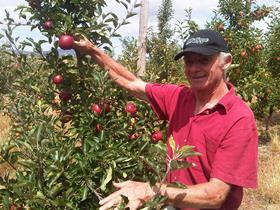
The Gala apple family has a new member and South Africa’s apple and pear marketers Tru-Cape Marketing hopes that, true to its name, the newly discovered apple Bigbucks will earn a lot of money for them.
The new apple was discovered by Buks Nel, Tru-Cape’s varietal expert, in an orchard on Oak Valley Estate in January 2011. The apple is a mutation of Corder Gala, also a strain discovered by a Tru-Cape grower, and is set to be successful because of its high colour and stability, to important criteria that plague the Gala-type apple.
Tru-Cape’s managing director Roelf Pienaar told Fruitnet that like Royal Beaut, discovered by Robert Zulch on Wakkerstroom in the Witzenberg Valley in Ceres, Corder Gala by Derek Corder on Beaulieu in Grabouw and now Bigbucks by industry veteran Buks Nel, Tru-Cape continues to lead development of better strains and best growing practices.
“We are incredibly proud of Buks as this discovery is just reward for a lifetime of passion and commitment to the fruit industry and frequent orchard walks - something of a rarity nowadays,” Pienaar said.
“Deep in its soul a Gala is an unstable varietal with between 5 per cetnt and 50 per cent of trees planted not being true to type. Bigbucks is the exception, so growers know when they plant a Bigbucks tree they will always get Bigbucks fruit,” Nel added. “Another, albeit cosmetic improvement, is the deep full wine red that the fruit achieves from early in its life while most other Gala types are striped.”
Nel said while redness is usually an indication of ripeness, with Bigbucks the fruit is full red from the start, which also means a higher percentage packout and profitability.
“Normally a Gala tree needs to be picked on three different occasions to find fruit of the right colour spec, now trees can be picked once,” Nel said. “I have always had a soft spot for this New Zealand-bred variety by Bill Ten Hove which we started to test here in the Cape in the 1970s. I remember how hard it was to convince the then Deciduous Fruit Board that Royal Gala had real potential in our South African apple industry. At the time, they thought it might be confused with an over-ripe Starking! A few of us believed in Royal Gala and in the Two-a-Day Group, one of the owners of Tru-Cape, we planted the first Royal Gala at Oak Valley Estates and grafted some trees on other farms within the Group.”
Ceres grower Calla du Toit, Tru-Cape’s procurement manager, assisted Nel with the registering of Plant Breeders’ Rights (PBR), valid for 25 years.
Although the numbers are still being finalised, growers that purchase Bigbucks will pay a royalty to plant the tree and a levy on every carton of Bigbucks fruit being sold. Tru-Cape will manage this process and ensure the returns are shared among the PBR owners. They are Buks Nel, Derek Corder, because Bigbucks is a hybrid of the Corder Gala and Anthony Rawbone-Viljoen of Oak Valley, where Nel found the first fruit.
According to Du Toit, Bigbucks trees planted in Ceres show the same potential as those planted in the Grabouw region.
“With its more than 90 per cent packout potential, this variety is set to be the most significant find of the decade. This pack out represents a 30 per cent improvement over most other varieties.”
Du Toit adds that Gala is among the most planted varieties in the world and there is every reason to think that the 1,700 Bigbucks trees currently in the ground and the 20,000 to be planted this next season, will grow exponentially in future. An indication of potential can be seen from the success of Royal Beaut of which more than 170,000 trees were planted last year.
“There is a myth that redder fruit has less flavour but this is an old wives’ tale. Bigbucks is beautiful to look at and delicious to eat,” Nel said. “Although it will take some years before there is sufficient volume to market commercially, as trees normally take between five and seven years for full production, this is something to which we all can look forward.”



